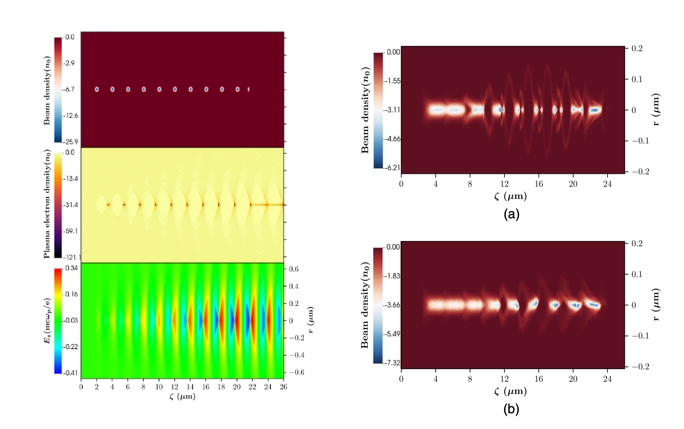Resonant excitation of very high gradient plasma wakefield accelerators by optical-period bunch trains

Within LIV.DAT, Monika Yadav’s project involves the study of drive and witness of beams in plasma wakefield accelerators (PWFAs). Monika is currently based at the University of California, Los Angeles (UCLA) as a visiting graduate researcher – her research is split between California and Liverpool.
Monika together with colleagues at UCLA authored a paper reporting on Resonant excitation of very high gradient plasma wakefield accelerators by optical-period bunch trains, which was recently published in Physical Review Accelerators and Beams (PRAB).
The use of a periodic electron beam bunch train to resonantly excite plasma wakefields in the quasinonlinear (QNL) regime has distinct advantages over employing a single, higher charge bunch. Resonant QNL excitation can produce plasma electron blowout using a small charge per pulse if the beam emittance beams are very low. The local density perturbation in such a case is extremely nonlinear, achieving total rarefaction, yet the resonant response of the plasma electrons at the plasma frequency is preserved. The needed electron beam pulse train with interbunch spacing equal to the plasma period can be produced via inverse free-electron laser bunching.
As such, in achieving resonance with a laser wavelength of a few microns, a high plasma density is employed, with the attendant possibility of obtaining extremely large wakefield amplitudes, near 1 TV/m^-1 for FACET-II parameters. In this paper, we use particle-in-cell (PIC) simulations to study the plasma response, the beam evolution including density modulation, and the instabilities encountered when using a bunched-beam scheme to resonantly excite waves in a dense plasma.
A key advantage here is shared with the application of very low emittance beams to driving an x-ray FEL—the final compression of the beam (which yields resonance in a very high density plasma in the QNL regime) is performed via the IFEL process. This permits obtaining of very high peak current while avoiding many of the deleterious effects of conventional compression, such as induced emittance growth and energy spread. Emittance growth is particularly damaging, as it limits the peak beam density attainable to drive plasma wakefields in the QNL regime, and exacerbates issues such as head erosion.
Experimental preparation in both QNL PWFA and x-ray FEL cases begins with the creation of the beam, and in this regard it is noted that since the time of the experiments and the initial analysis, that significant improvements in the approach to obtaining higher brightness electron beams have been introduced, an analysis of IFEL-induced microbunching for ultrahigh brightness, 10 GeV-class beams has already been performed. The efficacy of IFEL microbunching has further been validated by the successful results of the XLEAP experiment at SLAC, with the achievement of high brightness microbunches verified through the generation of attosecond x-ray FEL pulses. To enable the experimental cases analyzed here, one must introduce, in addition to a high brightness electron source, a laser modulation and bunching system as employed in XLEAP.
The resonant excitation of PWFA with an optical-IR period microbunch train promises to be a robust alternative for accessing TV/m-class plasma wakefields. This initiative takes advantage of recent experimental progress in microbunch creation in high brightness electron beams at multi-GeV energy. Further, with small modifications to existing infrastructure at FACET-II, experimental parameters relevant to E-317 described here will be enabled. In this regard, we note that the use of micro- bunched beams with attosecond structure are also needed for E-318, an ultrafast atomic physics experiment planned for FACET-II. This experiment, which can uniquely explore atomic electron dynamics under the influence of TV/m unipolar electric fields, is highly synergistic with the PWFA experiments described above, exploring effects which may be exploited as diagnostics in E-317.
Further information
[1] P. Manwani, N. Majernik, M. Yadav, C. Hansel, and J. B. Rosenzweig, Resonant excitation of very high gradient plasma wakefield accelerators by optical-period bunch trains, Phys. Rev. Accel. Beams 24, 051302
https://doi.org/10.1103/PhysRevAccelBeams.24.051302
Image: Left: PIC simulation snapshots of the beam charge density, plasma electron density, and longitudinal electric field for the ten bunches followed by a witness bunch. Right: Observed beam destruction due to phase shifting of the plasma wake (a) and hosing instability (b) [1]